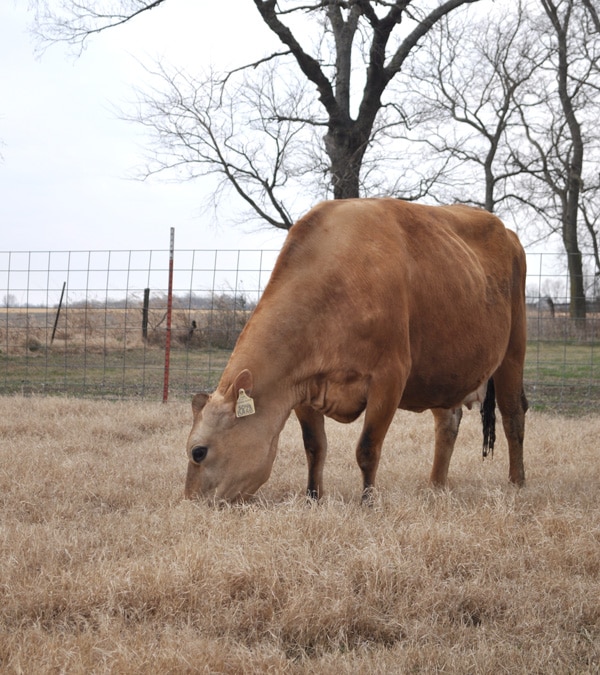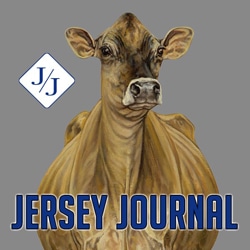Tips for Pre-Fresh Jersey Cows
The three-weeks either side of calving are tremendously stressful for the dairy cow. As she prepares to calve, give birth, and begin lactating, her metabolic, nutrition, and social needs change. Producers who are mindful of this when establishing pre-fresh protocol set the stage for healthy, profitable cows across their lactations.
With the rise of Jerseys in dairy herds milking other breeds come questions about breed differences. Though all dairy cows can be managed largely the same, there are a few key differences between Jerseys and other breeds, especially Holsteins. Consider this:
- Under less-than-ideal conditions, Jerseys have more transition challenges. Perhaps because they are smaller, changes of any kind are more impactful.
- Jerseys are three times more likely to experience milk fever as compared to Holsteins when managed in the same, poor conditions. Regardless of breed, it is estimated that half the cows in the herd will experience subclinical milk fever on the day of calving.
- Though pre-partum dry matter intake (DMI) for all cows drops before calving, it drops less among Jerseys as compared to Holsteins. Capitalize on this advantage by providing a stellar environment.
- Jerseys are notoriously good at sorting rations, so make sure feed is prepared properly so these ladies consume the entire ration.
- The individuals most susceptible to metabolic diseases at calving are high producers and older cows, especially in their third lactation or greater. This is a consideration for Jerseys because, as a breed, they have a longer productive life.
- Jersey cows deposit subcutaneous fat differently than Holsteins, with more fat between the tailhead and pins and less over the ribs and thurls. Keep this in mind when assigning body condition scores and evaluating cattle, especially at dry off and in early lactation.
In this article, we will focus on management of Jerseys in the close-up period, 21 days before calving. Tips have come from nutritionists who specialize in Jerseys and resources at the American Jersey Cattle Association.
Do Everything You Can to Maintain Dry Matter Intake
For all cows, nearly all negative events associated with calving hinge on reduced DMI. In the days before calving, a perfect storm is created by a reduction of feed intake coupled with an increase in nutritional needs.
Declining intake leads to negative energy balance. Cows in negative energy balance are susceptible to higher rates of subclinical and clinical ketosis. Suppressed immunity sets them up for a myriad of other diseases. These animals are 3-8 times more likely to get a displaced abomasum, and 2-5 times more likely to experience metritis.
To get your cows out of the gates running, make sure DMI is maintained BEFORE they calve. Ensure a balanced, unsortable ration is always in front of close-up cows. Avoid empty bunk syndrome by monitoring bunks ‘round the clock, even in the wee hours of the morning when no one is around. Consider installing a video camera for this purpose or use automatic feeders that sense when feed is not available.
Though the typical drop in DMI among Holsteins is twice that of Jerseys, you still need to pay attention to feed intake no matter which breed you milk. Research (French 2006) shows DMI among Holsteins drops 19% (from 2.1% of bodyweight to 1.7%) during the pre-fresh period while Jerseys fall 9% (from 2.2% of bodyweight to 2.0%).
Monitor Urine pH to Evaluate Metabolic Acidification
Cows that are “metabolically acidified” are less likely to experience sub-clinical hypocalcemia and clinical milk fever. A simple cow side urine pH test can help you determine whether cows are metabolically acidified or not.
While an ideal range for Holsteins is a urine pH of 6.2 to 6.7, Jerseys fare better with slightly more acidic urine, in the range of 5.8 to 6.2. Strive to maintain this delicate balance because a higher urine pH is associated with more cases of milk fever, a lower urine pH with retained placentas.
Approach urine pH testing as a means of developing benchmarks for the herd, so you can pinpoint causes for variation, like a change in the ration. Monitor urine pH to establish a range for the herd rather than to treat individual cows. Because cows are different ages and eat differently, you can expect variations. Strive for a tighter range but understand there will be stragglers outside this range.
To get useful benchmarks, establish protocol and follow it. Test cows that have been on a pre-fresh diet for at least three days and at the same time each day. Ideally test 4-6 hours after feeding. For large herds, test a group of 12 cows weekly. For smaller herds, spot-test monthly.

Feed a Dietary Cation-Anion Difference (DCAD) Diet
Feeding a negative DCAD diet to Jerseys is especially critical because they are susceptible to milk fever.
For Jerseys, diets of -5 to -12 milliequivalent (mEq) per gram should produce an appropriate reduction in urine pH. Keep in mind that the total amount of anions versus cations consumed will determine metabolic acidification. This again stresses the importance of maintaining DMI.
Anionic minerals like calcium sulfate, calcium chloride, ammonium chloride and commercially available supplements that rely primarily on chloride can be used to acidify the diet.
Aim to have cows on the negative DCAD diet for at least 14 days. Use 21 days as a target for the close-up period as some animals will calve early. If twins are diagnosed, feed the negative DCAD diet for 28 days.
If animals of varying ages and breeds need to be grouped together in the close-up pen, be sure to consider the needs of the most susceptible―third lactation Jersey cows―and formulate a ration that meets their needs first.
Use Nutrition Requirements from NRC for Jerseys
There is little evidence to support straying too far from the National Research Council’s recommendations for dairy cattle when feeding Jerseys. Nutrition requirements are likely very similar when production is expressed as pounds of energy corrected milk.
The current recommendations released in 2001 were based primarily on Holstein research. Future recommendations are expected to include more Jersey data.
In the pre-fresh ration, focus on high quality forages from a variety of sources to support a diverse rumen microbiome. Provide adequate soluble carbohydrates so cows will easily adjust to the lactating diet.
Perhaps of more significance than what is fed is how it is fed. Jerseys are very good at sorting the ration, so make sure it is prepared properly. If they are not eating the entire ration, estimates for DMI will be off.
Increase Dietary Calcium with DCAD Diet
If feeding a negative DCAD diet, total calcium concentrations should be greater than a conventional diet. Aim for cows to be consuming 180-200 grams of calcium.
Be mindful of the source of calcium and how it is processed as this affects availability. For example, on paper, a ration might be balanced for calcium with coarsely ground limestone. However, the true availability of calcium is lower with coarsely ground limestone than finely ground limestone or dicalcium phosphate.
Establish Case Definitions
To effectively identify, treat and determine magnitude of disease, it is important to establish case definitions―standard criteria that classifying existence. This area is far grayer than one might think. Ask 10 people what defines retained placenta or mastitis and you will likely get 10 different answers.
Establish clear and precise definitions for your farm. For example, will cases of ketosis be counted when diagnosed? Or will elevated levels of beta hydroxybutyrate (BHBA) on a ketosis meter suffice? Is a retained placenta diagnosed at 12 hours (the true medical case definition) or will a retained placenta at 24 hours be counted as such? And, what is to be done with the data?
Effective case definitions define disease, treatments, and methods of recording. As well, consider farm goals for the disease and actions for remedy should goals not be met.
Minimize Stress, Maximize Cow Comfort
In the weeks leading to calving, the dairy cow is going through tremendous hormonal changes. Do everything you can to make her comfortable and promote routine and sameness. Any time animals are moved, expect drops in DMI and increases in cortisol from stress.
Cows are social animals so be mindful of moving them and changing pens. You don’t want them to have to re-socialize with another group of animals, especially right before calving. As well, keep in mind that cows prefer to be with other animals at calving, not in individual pens. Just make sure you are providing enough space.
A good rule of thumb for stocking density is the 80% rule, meaning 80% of the headlocks or lying space is being utilized, with 20% free.
Regularly Monitor Gestation Length
While it is true that the average gestation length of a Jersey is 278 days, every dairy producer can tell you cows deviate from the norm most of the time. Among others, gestation is affected by calf gender, season, geographic location, and genetics.
This makes a huge impact on the stocking density of the pre-fresh pens. Undershoot this number by just a few days and your cows could be short on the DCAD diet. Overshoot it and pens could be burgeoning with close-up animals.
Regularly evaluate gestation length to establish benchmarks for your herd based on lactation number, season and use of sexed semen
Freshen Jerseys with Body Condition Scores of 3.5 to 4.0
Anecdotal evidence shows Jerseys transition better to the milking string with slightly higher body condition scores than Holsteins. Shoot to dry off and freshen Jerseys with scores of 3.5 to 4.0.
This difference, though, may be attributed to the way body scores are assigned, rather than an overall heavier condition. Dairy producers who are familiar with Holsteins may overscore Jerseys because they deposit more fat between the hooks and pins.
To determine effective benchmarks for the herd, assign the task of body condition scoring to one person on the farm. Or make sure your protocol for assigning body condition scores is impeccable and employees have been educated on breed differences.
The ideally conditioned Jersey will have a soft “U” between the hooks and pins and evidence of the last 1-2 ribs as she walks, but not when she stands.
When animals are moved to close-up pens and fresh cow pens, keep animals with similar body condition scores together. Shoot for variation under 10%. This will allow you to better manage the ration and easily spot outliers.

In Summary
When it comes to effectively managing animals through this transition, keep two things in mind―get them eating and make them comfortable―and everything else will follow suit.
For additional information on transition cows, watch the first of two YouTube videos presented by National All-Jersey Inc. at https://www.youtube.com/watch?v=b5pt5PxYIJY. This video focuses on pre-fresh cows. A second video on fresh cows can be viewed at https://www.youtube.com/watch?v=Jhk7ZgLHLx8.




